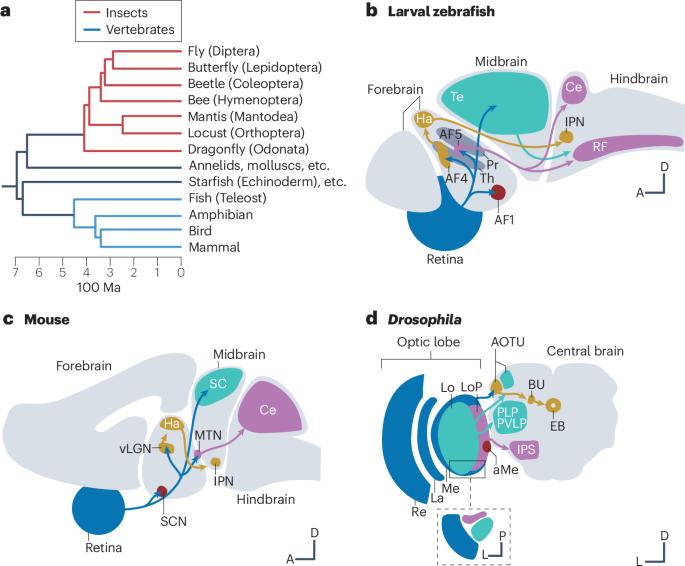On analogies in vertebrate and insect visual systems
IF 26.7
1区 医学
Q1 NEUROSCIENCES
引用次数: 0
Abstract
Despite the large evolutionary distance between vertebrates and insects, the visual systems of these two taxa bear remarkable similarities that have been noted repeatedly, including by pioneering neuroanatomists such as Ramón y Cajal. Fuelled by the advent of transgenic approaches in neuroscience, studies of visual system anatomy and function in both vertebrates and insects have made dramatic progress during the past two decades, revealing even deeper analogies between their visual systems than were noted by earlier observers. Such across-taxa comparisons have tended to focus on either elementary motion detection or relatively peripheral layers of the visual systems. By contrast, the aims of this Review are to expand the scope of this comparison to pathways outside visual motion detection, as well as to deeper visual structures. To achieve these aims, we primarily discuss examples from recent work in larval zebrafish (Danio rerio) and the fruitfly (Drosophila melanogaster), a pair of genetically tractable model organisms with comparatively sized, small brains. In particular, we argue that the brains of both vertebrates and insects are equipped with third-order visual structures that specialize in shared behavioural tasks, including postural and course stabilization, approach and avoidance, and some other behaviours. These wider analogies between the two distant taxa highlight shared behavioural goals and associated evolutionary constraints and suggest that studies on vertebrate and insect vision have a lot to inspire each other. The visual systems of vertebrates and insects exhibit considerable similarities. In this Review, Tanaka and Portugues discuss these similarities, focusing primarily on recent works in larval zebrafish and fruitflies and expanding the scope of the comparison from past examinations of this area.


关于脊椎动物和昆虫视觉系统的类比
尽管脊椎动物和昆虫之间的进化距离很远,但这两个分类群的视觉系统却有着惊人的相似之处,这一点已经被反复指出,包括神经解剖学先驱Ramón y Cajal在内。在神经科学中转基因方法的推动下,对脊椎动物和昆虫视觉系统解剖和功能的研究在过去二十年中取得了巨大进展,揭示了它们视觉系统之间比早期观察者所注意到的更深层次的相似之处。这种跨类群的比较往往集中在基本的运动检测或视觉系统的相对外围层。相比之下,本综述的目的是将这种比较的范围扩展到视觉运动检测之外的路径,以及更深层次的视觉结构。为了实现这些目标,我们主要讨论了最近在幼体斑马鱼(Danio rerio)和果蝇(Drosophila melanogaster)中研究的例子,这是一对遗传上易于处理的模式生物,它们的大脑相对较小。特别是,我们认为脊椎动物和昆虫的大脑都配备了三阶视觉结构,专门负责共同的行为任务,包括姿势和路线稳定,接近和回避,以及其他一些行为。这两个遥远的分类群之间的更广泛的相似性突出了共同的行为目标和相关的进化限制,并表明脊椎动物和昆虫视觉的研究有很多相互启发的地方。
本文章由计算机程序翻译,如有差异,请以英文原文为准。
求助全文
约1分钟内获得全文
求助全文
来源期刊

Nature Reviews Neuroscience
NEUROSCIENCES-
自引率
0.60%
发文量
104
期刊介绍:
Nature Reviews Neuroscience is a multidisciplinary journal that covers various fields within neuroscience, aiming to offer a comprehensive understanding of the structure and function of the central nervous system. Advances in molecular, developmental, and cognitive neuroscience, facilitated by powerful experimental techniques and theoretical approaches, have made enduring neurobiological questions more accessible. Nature Reviews Neuroscience serves as a reliable and accessible resource, addressing the breadth and depth of modern neuroscience. It acts as an authoritative and engaging reference for scientists interested in all aspects of neuroscience.
 求助内容:
求助内容: 应助结果提醒方式:
应助结果提醒方式:


